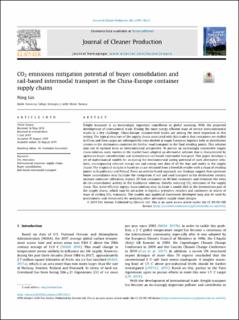| dc.contributor.author | Lin, Ning | |
| dc.date.accessioned | 2023-10-10T10:34:08Z | |
| dc.date.available | 2023-10-10T10:34:08Z | |
| dc.date.created | 2019-08-21T15:20:29Z | |
| dc.date.issued | 2019 | |
| dc.identifier.citation | Journal of Cleaner Production. 2019, 240 (December), 1-13. | en_US |
| dc.identifier.issn | 0959-6526 | |
| dc.identifier.uri | https://hdl.handle.net/11250/3095448 | |
| dc.description.abstract | Freight transport is an increasingly important contributor to global warming. With the projected development of international trade, finding the most energy efficient ways of service intercontinental trades is a key challenge. China-Europe containerized trades are among the most important in this setting. The typical structure of the supply chains associated with this trade is that containers are stuffed in China and then cargos are subsequently cross-docked at major European logistics hubs or distribution centers in the destination countries for further road transport to the final retailing points. This solution may not be optimal from an environmental perspective. To pursue an increasingly sustainable supply chain solution, early movers in the market have adopted an alternative solution that is characterized by upstream buyer consolidation and downstream rail-based intermodal transport. This paper develops a set of mathematical models for analyzing the environmental saving potential of such alternative solutions, encompassing relevant energy use and energy mix data of all the legs and nodes in the supply chains. The empirical analysis is based on a case obtained from a Swedish retailer with a chain of retailing points in Scandinavia and Poland. From an activity-based approach, our findings suggest that upstream buyer consolidation may facilitate the integration of rail and road transport in the destination country, increase container utilization, replace 20-foot containers by 40-foot containers and eliminate the extra de-/re-consolidation activity in the traditional solution, thereby reducing CO2 emissions of the supply chain. This, more efficient supply chain solution, may facilitate a modal shift in the downstream part of the supply chains, which may be attractive to logistics providers, retailers and customers in search of ways of curbing CO2-emissions. The models and analytical framework developed may also be used by practitioners and researchers for analyzing other alternative supply chain designs. Keywords: CO2 emissions, international container supply chains, buyer consolidation, rail-based intermodal transport | en_US |
| dc.language.iso | eng | en_US |
| dc.relation.uri | https://doi.org/10.1016/j.jclepro.2019.118121 | |
| dc.rights | Attribution-NonCommercial-NoDerivatives 4.0 Internasjonal | * |
| dc.rights.uri | http://creativecommons.org/licenses/by-nc-nd/4.0/deed.no | * |
| dc.title | CO2 emissions mitigation potential of buyer consolidation and rail-based intermodal transport in the China-Europe container supply chains | en_US |
| dc.type | Peer reviewed | en_US |
| dc.type | Journal article | en_US |
| dc.description.version | publishedVersion | en_US |
| dc.source.pagenumber | 1-13 | en_US |
| dc.source.volume | 240 | en_US |
| dc.source.journal | Journal of Cleaner Production | en_US |
| dc.source.issue | December | en_US |
| dc.identifier.doi | 10.1016/j.jclepro.2019.118121 | |
| dc.identifier.cristin | 1717768 | |
| cristin.ispublished | true | |
| cristin.fulltext | original | |
| cristin.qualitycode | 2 | |

